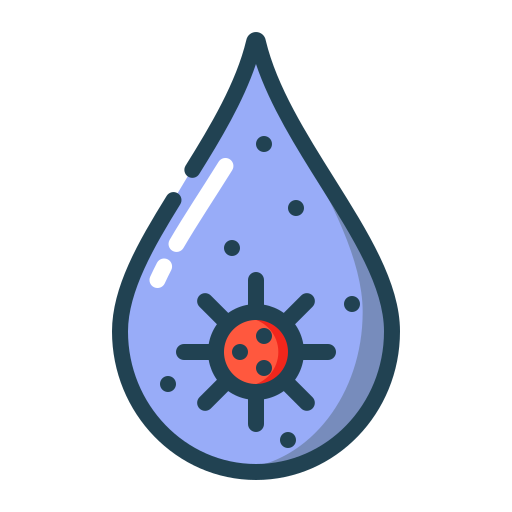Why We Are Here…
SafeDrinkingWaterToday.com is a public information site created by local residents to help raise awareness about PFAS (Per- and Polyfluoroalkyl Substances) contamination in drinking water supplied by New Jersey American Water in Warren County, NJ.
We are not affiliated with any government agency or utility. We do not offer legal, health, or environmental advice. We only share publicly available information to help residents understand the risks and take informed action.
What Are PFAS?
PFAS are a group of man-made chemicals used for decades in products like:
- Non-stick cookware (e.g., Teflon™)
- Waterproof gear (e.g., GORE-TEX™)
- Stain-resistant fabrics (e.g., Scotchgard™)
- Firefighting foam and industrial equipment
These chemicals do not break down in the environment and can build up in the body over time. The most studied PFAS—PFOA and PFOS—have been linked to:
- Increased cancer risk
- Liver and kidney damage
- Immune system effects
- Developmental harm in infants and children
Learn more from the EPA PFAS website
What is in Our Water?
According to New Jersey American Water’s published 2024 report, PFAS levels in our water are:
- PFOA: 6 parts per trillion (ppt) 33.33% above the Maximum Contaminant Level (MCL)
- PFOS: 10 parts per trillion (ppt) 60% above the above the Maximum Contaminant (MCL)
The new federal maximum legal limit (MCL) is 4 ppt, but utilities do not have to be in compliance until 2029. Until then, New Jersey American Water customers serviced in Washington / Oxford are being exposed to PFOA levels 33.33% higher than the maximum contaminant level (MCL) and PFOS levels 60% higher than the maximum contaminant level (MCL).
The EPA 2029 Requirements
In April 2024, the EPA finalized its first-ever enforceable PFAS regulation:
- Enforcement of violations will begin in 2029
- 4 ppt is the maximum legal limit (MCL) for PFOA and PFOS in supplied water
- Initial testing required by 2027
- Full compliance is required by 2029 unless an extension is applied for
What They Are Doing In Other Areas… Why Is It Not Being Done Here?
New Jersey American Water has installed advanced PFAS filtration technology at its Short Hills Well Station, but this has not yet been implemented in the Washington / Oxford water systems with high PFAS contamination levels above 4 ppt serving 10,719 service addresses of Warren County residents.
Scope of Problem
There are 10,719 locations currently served by New Jersey American Water from the Washington / Oxford system per the EPA PFAS Analytic Tool. https://awsedap.epa.gov/public/extensions/PFAS_Tools/PFAS_Tools.html
What Can You Do Right Now?
Avoid Drinking or Cooking with Tap Water
Use bottled water or install PFAS-certified filters for all drinking and cooking water. Boiling your water does not remove PFAS.
Types of Filtration
Reverse Osmosis Filtration
Reverse osmosis (RO) systems are an effective way to remove PFAS (forever chemicals) from drinking water, according to the EPA. RO systems use a membrane to force water through, separating contaminants like PFAS from the water. The EPA identifies RO as one of the “Best Available Technologies” for removing PFAS. [1, 2, 3]
Here’s a more detailed explanation: [4, 4]
- How RO works: RO systems use pressure to force water through a semi-permeable membrane with tiny pores. This process separates contaminants like PFAS from the water, creating treated water (permeate) and a stream of reject water (concentrate). [4, 4]
- Effectiveness: RO can be highly effective at removing PFAS, with some studies showing effectiveness up to 99% for certain PFAS. [1, 1]
- EPA’s perspective: The EPA considers RO, along with other technologies like granular activated carbon (GAC), anion exchange, and nanofiltration, as “Best Available Technologies” for meeting PFAS Maximum Contaminant Levels (MCLs) in drinking water. [3, 3]
- Certification: It’s important to note that current NSF/ANSI 58 certification standards for RO systems do not yet indicate that a filter will remove PFAS to the levels required by the EPA’s drinking water standards. [2, 2]
- WaterSense: The EPA’s WaterSense program also provides guidelines for selecting RO systems, including those that are more water-efficient, according to EPA guidelines. [5, 5]
- Point-of-use vs. point-of-entry: RO systems can be installed as point-of-use systems (under the sink or at a specific faucet) or point-of-entry systems (treating all the water in the home). Point-of-use systems are generally more economical. [6, 6, 7]
In summary: RO systems are a viable option for removing PFAS from drinking water, but it’s essential to choose certified systems and be aware of their water efficiency and maintenance needs. [2, 6]
[1] https://www.watertechnologies.com/blog/does-reverse-osmosis-treat-pfas
[2] https://www.epa.gov/system/files/documents/2024-04/water-filter-fact-sheet.pdf
[3] https://www.epa.gov/system/files/documents/2024-04/pfas-npdwr_fact-sheet_treatment_4.8.24.pdf
[4] https://www.epa.gov/watersense/point-use-reverse-osmosis-systems
[5] https://www.epa.gov/system/files/documents/2024-11/ws-products-ro-systems-mini-report.pdf
[6] https://www.health.state.mn.us/communities/environment/hazardous/topics/pfashometreat.html
The Concentrate or Brine from the Reverse Osmosis process contains the higher level of contiminants and if used with a septic system and leach field, it will lead to higher concentrations of the contaminants being deposited in the immeadiate area of the septic system.
Ion Anion Filtration
An EPA-approved ion exchange treatment anion filtration system uses synthetic resins to remove negatively charged contaminants from water. These resins exchange negatively charged ions like PFAS, arsenic, or chromium-6 with less harmful anions like chloride. This process can achieve high removal efficiencies, often greater than 99%. [1, 2, 3]
Here’s a more detailed explanation:
How it works:
- Water passes through a bed of synthetic resin. [2]
- Negatively charged contaminants in the water are attracted to the resin and exchanged for less harmful anions (like chloride) already present on the resin’s surface. [2, 3]
- This process effectively removes the contaminants from the water. [2]
Benefits of anion exchange:
- High removal efficiency: Anion exchange can remove contaminants to very low levels, according to the U.S. Environmental Protection Agency (.gov). [2, 4]
- Selective removal: Different resins can be used to target specific contaminants. [2]
- Regeneration: The resin can be regenerated to restore its capacity, making it a sustainable option. [2]
- Reduced disinfectant byproduct formation: Anion exchange can also help reduce the formation of harmful disinfection byproducts, according to the U.S. Environmental Protection Agency (.gov). [3]
Applications:
- PFAS removal: Anion exchange is a widely used treatment technology for removing PFAS (per- and polyfluoroalkyl substances) from drinking water, says the EPA. [3, 5]
- Other contaminants: It can also be used to remove other negatively charged contaminants like arsenic, chromium-6, and nitrate. [1, 2]
Regeneration:
- When the resin’s capacity is exhausted, it’s regenerated using a saturated solution of sodium chloride (brine) to restore its ability to remove contaminants. [2]
- Important note: The waste stream from the regeneration process needs to be managed appropriately, as it may contain concentrated contaminants. [6]
[1] https://www.epa.gov/sdwa/drinking-water-treatment-technology-unit-cost-models
[2] https://www.epa.gov/sdwa/overview-drinking-water-treatment-technologies
[3] https://www.epa.gov/system/files/documents/2024-04/pfas-npdwr_fact-sheet_treatment_4.8.24.pdf
[5] https://www.epa.gov/sciencematters/reducing-pfas-drinking-water-treatment-technologies
[6] https://www.epa.gov/sites/default/files/2015-04/documents/poster_treatment_technologies.pdf
Filters need to be regenerated, or changed and contaminants need to be disposed of properly.
Granular Activated Carbon Filtration
The EPA recommends Granular Activated Carbon (GAC) and reverse osmosis as effective methods for removing PFAS from drinking water. GAC filters work by trapping chemicals as water passes through them, while reverse osmosis uses a membrane with tiny pores to filter out PFAS. Both technologies are part of the EPA’s “Best Available Technologies” for meeting PFAS Maximum Contaminant Levels. [1, 2, 3, 4]
- Granular Activated Carbon (GAC): GAC is a porous material that effectively adsorbs (accumulates at its surface) organic compounds, including some PFAS. It’s widely used in both public water treatment systems and home water filters. [5, 5, 6, 6, 7, 7]
- Reverse Osmosis (RO): RO systems use a high-pressure membrane with very small pores to filter out a wide range of contaminants, including PFAS. They are considered highly effective and are a common choice for removing PFAS from water. [3, 3, 4, 4, 8]
- EPA Recommendations: The EPA recognizes both GAC and RO as effective technologies for addressing PFAS in drinking water. These technologies are part of the EPA’s “Best Available Technologies” (BATs) for meeting the Maximum Contaminant Levels (MCLs) for PFAS. [1, 1, 6, 6]
- Importance of Certification: When selecting a filter for PFAS removal, it’s crucial to choose one that is certified by a reputable organization like NSF International or Underwriters Laboratories (UL). These certifications indicate that the filter has been tested and proven to effectively remove PFAS. [7, 8, 8, 9, 9, 10]
- Maintenance: It’s essential to maintain water filters properly, following the manufacturer’s instructions for filter replacement. Failure to do so can reduce the filter’s effectiveness. [11, 11]
[1] https://www.epa.gov/system/files/documents/2024-04/pfas-npdwr_fact-sheet_treatment_4.8.24.pdf
[2] https://www.epa.gov/water-research/identifying-drinking-water-filters-certified-reduce-pfas
[3] https://www.watertechnologies.com/blog/does-reverse-osmosis-treat-pfas
[4] https://www.health.state.mn.us/communities/environment/hazardous/topics/pfashometreat.html
[5] https://www.epa.gov/sciencematters/reducing-pfas-drinking-water-treatment-technologies
[7] https://www.epa.gov/sciencematters/predicting-how-effective-water-filters-are-removing-variety-pfas
[8] https://www.canr.msu.edu/news/list-of-household-filters-approved-for-certain-pfas-removal
[9] https://qualitywaterlab.com/contaminants/water-filters-for-pfas/
[10] https://indianapublicradio.org/news/2023/07/what-to-do-if-there-are-pfas-in-your-water/
[11] https://www.epa.gov/system/files/documents/2024-04/water-filter-fact-sheet.pdf
The Concentrate or Brine from the Granular Activated Carbon (GAC) and Reverse Osmosis process contains the higher level of contiminants and if used with a septic system and leach field, it will lead to higher concentrations of the contaminants being deposited in the immeadiate area of the septic system.
NANO Filtration
Nano filtration (NF) is a water treatment technology that uses membranes to remove contaminants, particularly larger molecules like PFAS, from water, according to the U.S. Environmental Protection Agency (EPA). It’s a lower-pressure version of reverse osmosis (RO) and is effective at removing hardness, color, odor compounds, and synthetic organic chemicals, as well as some disinfection byproduct precursors. [1, 2]
Here’s a more detailed look: [1, 1, 2, 2]
- Contaminant Removal: NF removes contaminants by physically separating them from the water through a membrane. It’s particularly effective at removing larger molecules, including PFAS, while leaving behind smaller dissolved salts. [1, 1, 2, 2]
- Process: NF works by passing water under pressure through a membrane with very small pores. The water passes through, while contaminants are rejected and collected as a separate stream. [1, 1, 3, 4, 5]
- Applications: NF can be used in various settings, including water treatment plants and even point-of-use systems for homes. [1, 1, 6, 6]
- Advantages: NF can be a cost-effective way to treat water and remove a wide range of contaminants. [1, 1, 7, 7]
- Disadvantages: The main challenge with NF is the disposal of the concentrated contaminants stream (reject or brine). Also, it can be expensive to implement and maintain. [1, 1, 6, 6]
- Comparison to RO: While both NF and RO use membranes, RO removes almost all dissolved solutes, including small ions, whereas NF has a lower rejection rate for smaller molecules, according to DuPont. [1, 1, 8, 8]
- EPA’s Role: The EPA provides resources and guidance on NF and other drinking water treatment technologies, including the PFAS Roadmap and treatment fact sheets. [1, 1, 9, 9, 10, 10, 11]
[1] https://www.epa.gov/system/files/documents/2024-04/pfas-npdwr_fact-sheet_treatment_4.8.24.pdf
[2] https://www.epa.gov/sdwa/overview-drinking-water-treatment-technologies
[3] https://genesiswatertech.com/blog-post/seawater-purification-using-nanofiltration/
[4] https://iwaponline.com/ws/article/20/6/2043/74281/Pilot-study-on-nanofiltration-membrane-in-advanced
[5] https://searecovery.org/watermakers/nfm/
[6] https://www.epa.gov/sciencematters/reducing-pfas-drinking-water-treatment-technologies
[7] https://alliniwaterfilters.com/what-is-nanofiltration-and-how-can-it-improve-your-water-quality/
[8] https://www.dupont.com/water/technologies/nanofiltration-nf.html
[9] https://factor.niehs.nih.gov/2022/4/feature/3-feature-pfas-water-filter
[10] https://www.epa.gov/water-research/identifying-drinking-water-filters-certified-reduce-pfas
The Concentrate or Brine from the NANO Filtration process contains the higher level of contiminants and if used with a septic system and leach field, it will lead to higher concentrations of the contaminants being deposited in the immeadiate area of the septic system.
New Jersey American Water Water Quality Reports 2022-2024
New Jersey American Water – Oxford / Washington Water Quality Report 2024 (Page 17, PFOA / PFOS). The current MCL for PFOA and PFOS is 4 ppt, not the 14 ppt PFOA, and 13ppt PFOS shown on the New Jersey American Water Website. https://amwater.com/NJAW/resources/pdf/ccr/washingtonoxford_2024.pdf

New Jersey American Water – Oxford / Washington Water Quality Report 2023 (Page 18, PFOA / PFOS). The current 2025 MCL for PFOA and PFOS is 4 ppt. https://amwater.com/NJAW/resources/pdf/ccr/washingtonoxford_2023.pdf

New Jersey American Water – Oxford / Washington Water Quality Report 2022 (Page 18, PFOA / PFOS). The current 2025 MCL for PFOA and PFOS is 4 ppt. https://amwater.com/NJAW/resources/pdf/ccr/washingtonoxford_2022.pdf

New Jersey American Water Definitions
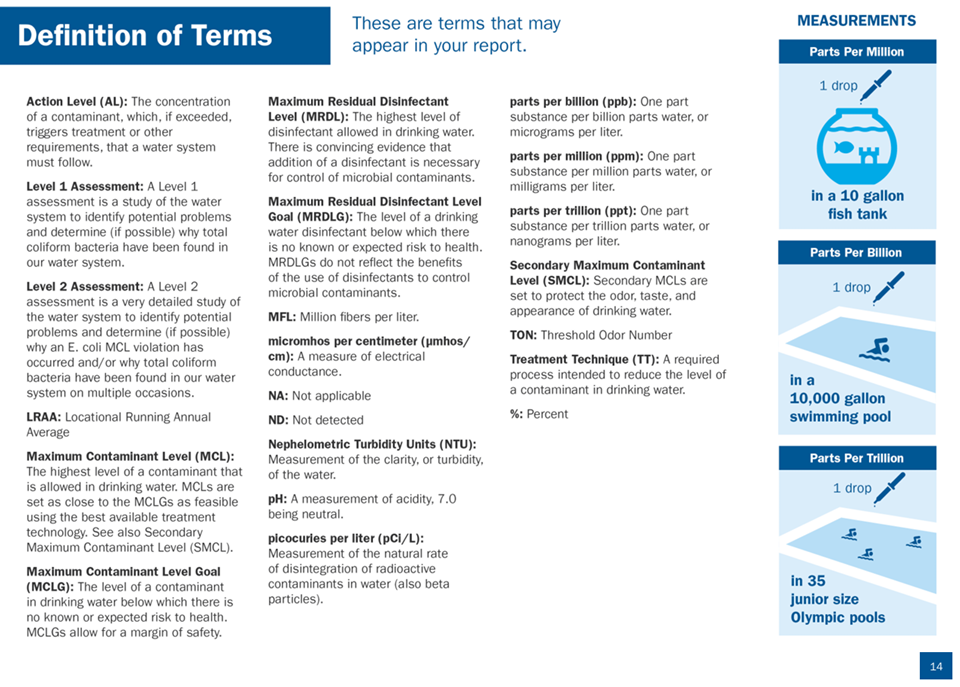
EPA 2029 PFOA, PFOS Enforcement Standards
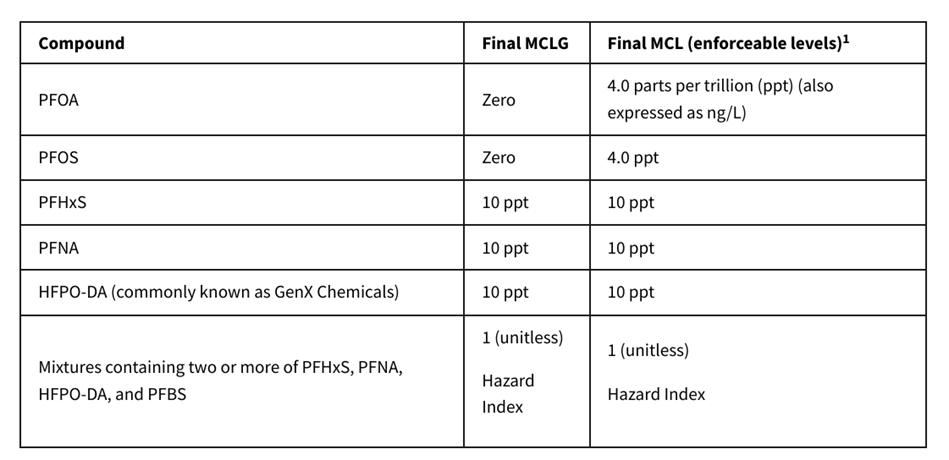
Monitor Your Health
Talk to your doctor about possible PFAS exposure and whether health screening is needed.
How PFAS Impacts Your Health | PFAS and Your Health | ATSDR
Stay Informed and Organized
Join our local advocacy efforts, share resources, and request updates from elected officials.
EPA “Route 31 Sludge Disposal Site” Drinking Water Contamination Presentation 04/30/2025
On 04/30/2025 at 6:00 pm, the most recent presentation by the Federal Environmental Protection Agency (EPA) of the major PFAS contamination issue in the Washington aera was held at the Warren County Vocational Technical School in Franklin Township regarding the “Route 31 Sludge Disposal Site” this is a significant water contamination problem in Washington and the surrounding areas. Power Point images and posters below are from the EPA “Route 31 Sludge Contamination” Presentation on 04/30/2025. This Presentation was targeted at residents with well water, not residents receiving city water service provided by New Jersey American Water. The Maximum Contaminant Level (MCL) for PFOA and PFAS is shown by a red dotted line in the second slide shown below.
315 addresses are listed for PFOA contamination in their well water, 159 have contaminant values over 4 ppt 50.4761% of the tested wells,
381 addresses are listed for PFOS contamination in their well water, 192 have contaminant values over 4 ppt 50.3937% of the tested wells.
These addresses have a contaminant level over 4 ppt MCL in their well water and are receiving bottled water and filtration systems at those addresses from the EPA.
There are 10,719 addresses and locations serviced and supplied by New Jersey American Water with PFOA and PFOS levels above the Maximum Contaminant Level (MCL) of 4 ppt in the water system for the Washington / Oxford area.
This situation is not being addressed beyond the passage of the legislation that calls for future enforcement in 2029 of the new standards, and that corrective actions must be in compliance by 2029 for these consumers.
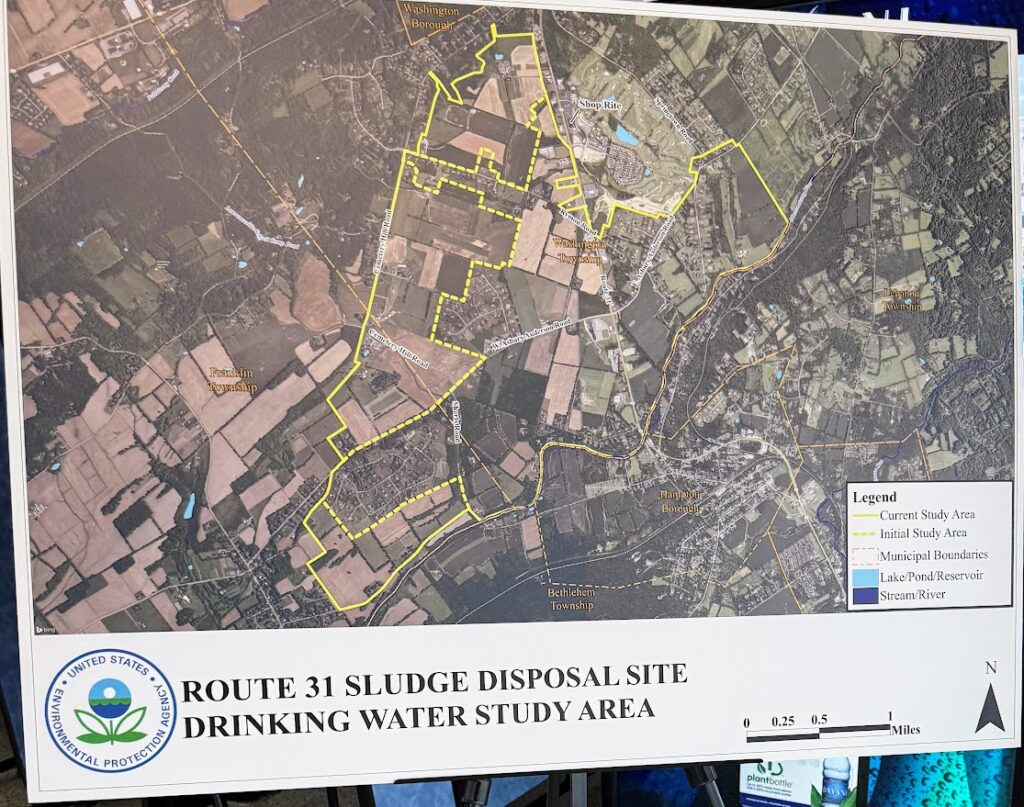
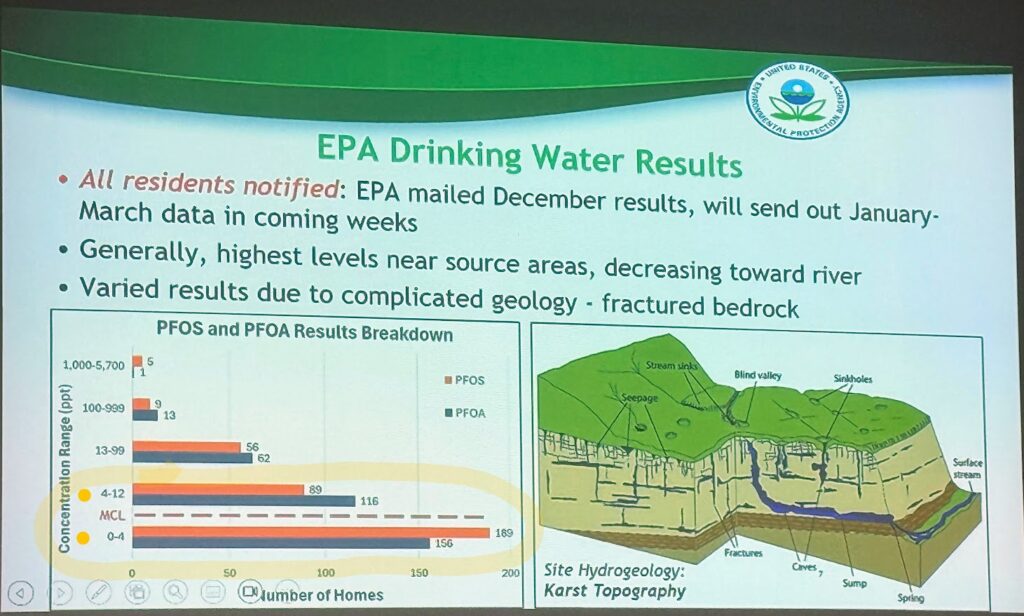

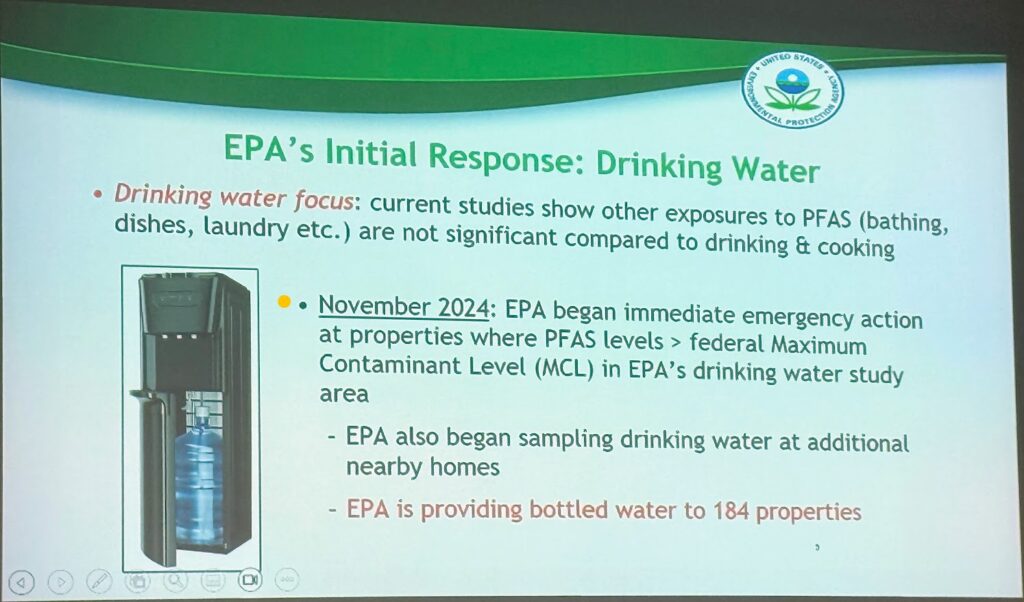
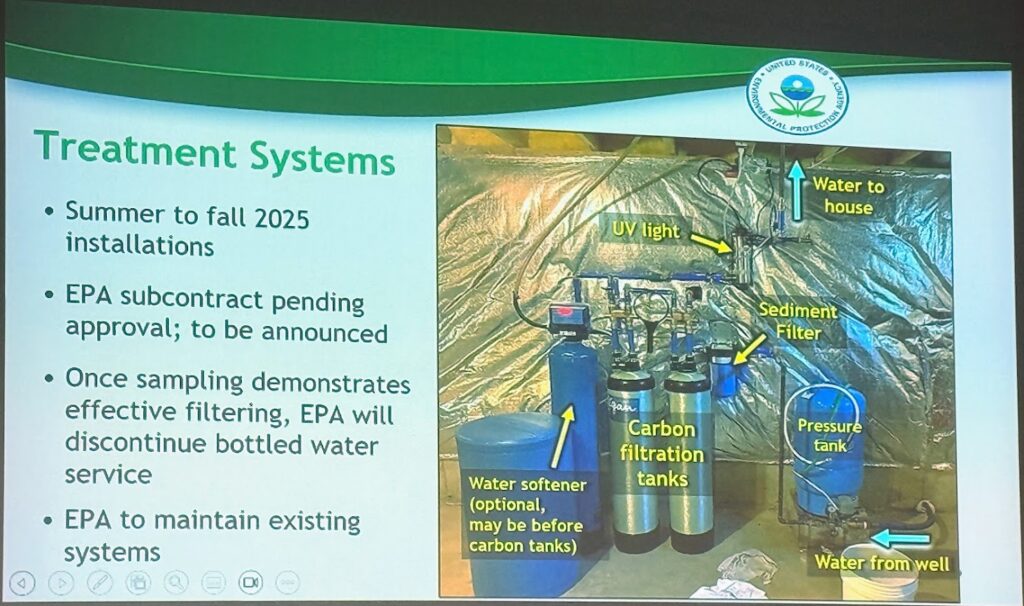
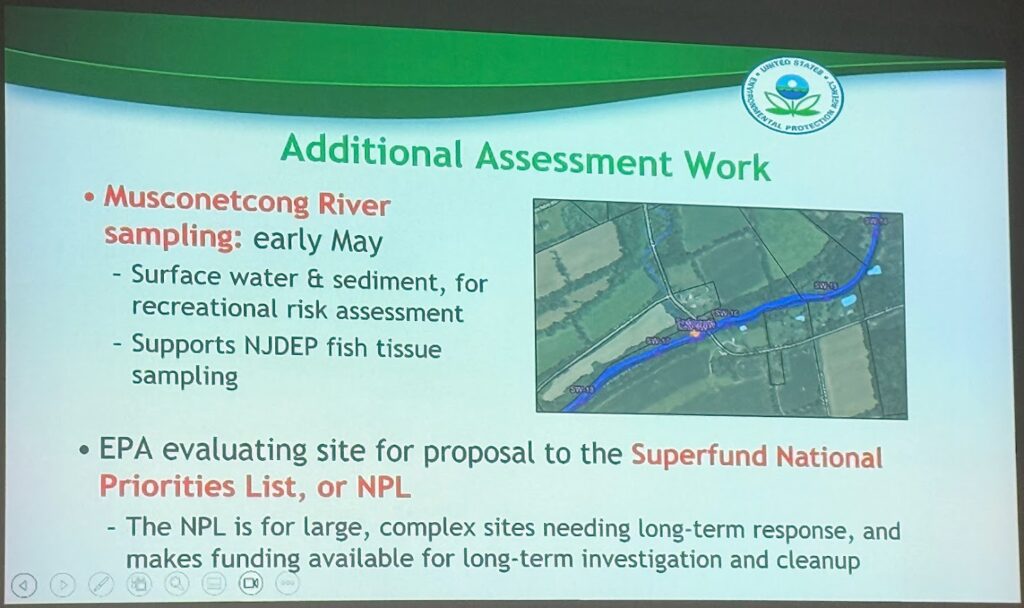
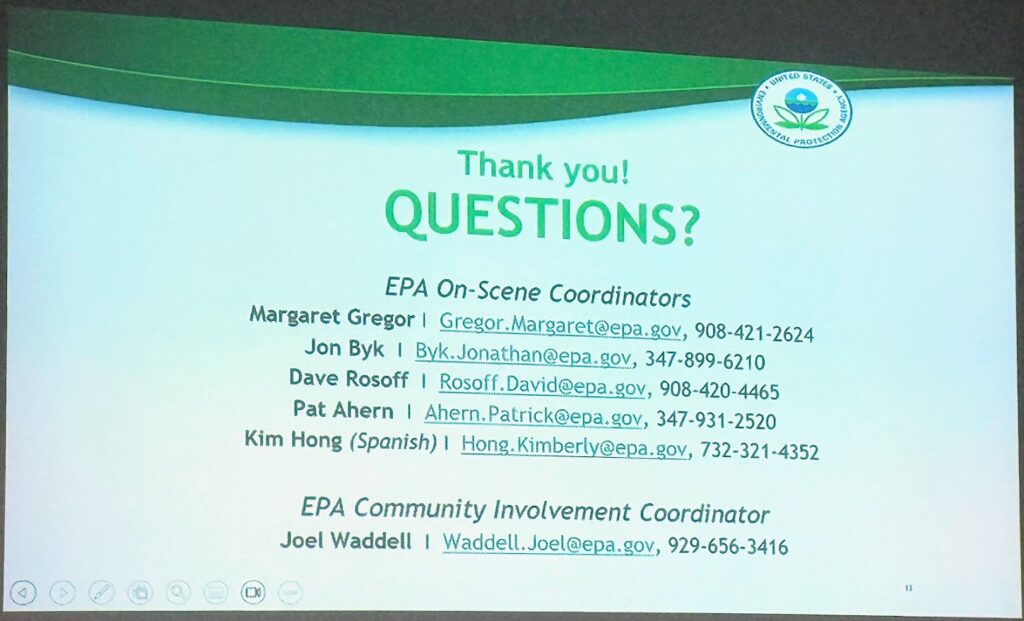
What The EPA Is Doing
New and additional updates to the federal legislation and requirements of the Clean Water Act (CWA) were passed in January of 2024.
The New Jersey Department of Environmental Protection was in charge of this situation centered around Rymon Road and Route 31 until it was handed over to the Federal Environmental Protection Agency (EPA) in late 2024.
The current focus is on well water use and the residents affected by the PFOS and PFOA contamination in the ground water and the farmed soil used for crops. 45 acres have been identified so far where these toxic chemicals from their sludge ponds at the plant were spread from the mid-1950s to the mid-1970s as fertilizer by the textile manufacturer, the potential for much more acreage to be identified in the future certainly exists.
During the question and answer session after the EPA’s presentation the representative for New Jersey American Water stated that the city water supplied by them has a higher than specified contamination of PFOS and PFOA levels enumerated in the requirement of the newly passed legislation. He further stated that New Jersey American Water has until 2029 to comply with the law. The current specified maximum acceptable levels are 4 ppt (parts per trillionth) and currently have tested between PFOA at 33% and PFOS at 60% above the Maximum Contaminant Level (MCL), that is well above the legal permissible limit, but compliance is not required until 2029. He further stated that New Jersey American Water is developing a plan with a test/pilot program to address this situation of the water they provide with a potential implementation of the fall of 2025.
Recently public presentations on this topic were held in December of 2024, and March of 2025, this contamination issue was previously identified in 2019 by the New Jersey Department of Environmental Protection to address the health concerns of those most seriously affected who have well water, there was no mention of the recipients of water provided by New Jersey American Water through watermains and the unacceptable contaminant levels of the product being delivered by them from the EPA.
Currently the EPA states bathing, laundry, cleaning and other uses of the subject water are acceptable, except for the ingestion and cooking with the contaminated water that has high levels of PFAS.
Current EPA Legislation And Action
In 2024, the Clean Water Act saw significant updates and developments, particularly regarding PFAS contamination, facility response planning, and state/tribal assumption of the permitting program. The EPA finalized rules for PFAS in drinking water, facility response plans for potential hazardous substance discharges, and modernized the program for states and tribes to administer Clean Water Act Section 404 permitting.
Here’s a more detailed breakdown of the key updates:
Drinking Water Standard:
The EPA finalized the first-ever national, legally enforceable drinking water standard for PFAS in April 2024.
Risk Assessment:
The EPA published a draft risk assessment for PFOA and PFOS in biosolids in January 2025, which will be used to determine whether to regulate these contaminants in biosolids.
Funding:
The EPA has also announced an additional $1 billion to help states and territories implement PFAS testing and treatment at public water systems and address PFAS contamination in private wells.
Per- and Polyfluoroalkyl Substances (PFAS)
Final PFAS National Primary Drinking Water Regulation
https://www.epa.gov/sdwa/and-polyfluoroalkyl-substances-pfas
Summary:
On April 10, 2024, EPA announced the final National Primary Drinking Water Regulation (NPDWR) for six PFAS. To inform the final rule, EPA evaluated over 120,000 comments submitted by the public on the rule proposal, as well as considered input received during multiple consultations and stakeholder engagement activities held both prior to and following the proposed rule. EPA expects that over many years the final rule will prevent PFAS exposure in drinking water for approximately 100 million people, prevent thousands of deaths, and reduce tens of thousands of serious PFAS-attributable illnesses.
EPA is also making unprecedented funding available to help ensure that all people have clean and safe water. In addition to the final rule, EPA announced $1 billion in available funding through the Infrastructure Investment and Jobs Act to help states and territories implement PFAS testing and treatment at public water systems and to help owners of private wells address PFAS contamination.
EPA established legally enforceable levels, called Maximum Contaminant Levels (MCLs), for six PFAS in drinking water: PFOA, PFOS, PFHxS, PFNA, and HFPO-DA as contaminants with individual MCLs, and PFAS mixtures containing at least two or more of PFHxS, PFNA, HFPO-DA, and PFBS using a Hazard Index MCL to account for the combined and co-occurring levels of these PFAS in drinking water. EPA also finalized health-based, non-enforceable Maximum Contaminant Level Goals (MCLGs) for these PFAS.
BROCHURE – THIS IS SUPERFUND: A COMMUNITY GUIDE TO EPA’S SUPERFUND PROGRAM – EPA 540-R-11-021
- NJDEP-Drinking WaterWatch
- https://www.nj.com/warren/2025/05/epa-expands-forever-chemicals-investigation-into-musconetcong-river.html
- ‘Startlingly high’ levels of ‘forever chemicals’ recorded in rural NJ | NJ Spotlight News
- Testing in rural Warren County at PFAS hot spot | NJ Spotlight News
- NJDEP| Division of Science and Research | PFAS
- NJDEP| Per- and Polyfluoroalkyl Substances, (PFAS) | EPA PFAS Rule
- https://response.epa.gov/site/site_profile.aspx?site_id=16763
- https://www.ehn.org/pfas-contamination-in-new-jersey-town-prompts-epa-investigation
- https://cumulis.epa.gov/supercpad/cursites/csitinfo.cfm?id=0201075
Other Contiminated Locations and Superfund Sites in Warren County, NJ
HIGH POINT SANITARY LANDFILL
This site operated as a sanitary landfill for approximately 30 years, beginning in the 1950s. Between the late 1960s and the
early 1980s, NJDEP and the county health department cited the landfill operators for a variety of violations, including
landfill fires, excessive slopes and expanding waste disposal operations beyond the approved area. In the early 1980s, the
county health department discovered low levels of volatile organic compounds in the ground water and surface water at
the landfill and in nearby private potable wells. Operations at the site ceased in 1983 upon order of NJDEP, but the landfill
was not properly closed in accordance with environmental statutes and solid waste regulations. A civil court named NJDEP
receiver of the landfill in 1984, making the Department responsible for its safe and proper closure. Between 1986 and 1987,
NJDEP regraded and capped the landfill and installed an interim leachate collection system. Approximately 150 drums
containing hazardous wastes were discovered during the regrading process, which were removed and disposed of at an offsite location. A public water line was also installed in 1986 to replace contaminated potable wells in the area.
In 1989, NJDEP began a Remedial Investigation and Remedial Action Selection (RI/RAS) to determine the nature and extent
of the contamination at the site and identify cleanup alternatives. The interim leachate collection system and the condition
of the landfill side slopes were also evaluated as part of this investigation. The RI/RAS concluded that the ground water,
surface waters and sediments at the site were only slightly contaminated and the levels of contaminants in these media were
gradually decreasing due to natural mechanisms. Approximately 320 cubic yards of landfill refuse were also discovered
outside the capped area during the RI/RAS. In 1996, after completing the RI/RAS, NJDEP issued a Decision Document for
the site. The Decision Document requires long-term monitoring of the ground water, surface water and sediments, and
institution of a Classification Exception Area/Well Restriction Area (CEA/WRA) to prevent unauthorized use of the ground
water. The Decision Document also requires sealing and backfilling of the leachate collection basin, regrading of the landfill
cover, implementation of erosion control measures, and off-site disposal of the uncapped refuse. In 1998, NJDEP and a
group of Potentially Responsible Parties for the site entered into an Administrative Consent Order that obligated the
Potentially Responsible Parties to implement the actions specified in the Decision Document. All future work will be
conducted under the supervision of NJDEP’s Division of Responsible Party Site Remediation

https://rucore.libraries.rutgers.edu/rutgers-lib/36971/pdf/1
https://cumulis.epa.gov/supercpad/CurSites/csitinfo.cfm?id=0200546
https://www.nj.gov/dep/dshw/recycling/admentme/Warren/090281cert.pdf
https://www.mcall.com/1984/03/22/work-at-landfill-said-ready-to-start/
POHATCONG VALLEY GROUND WATER CONTAMINATION
The Pohatcong Valley Ground Water Contamination Superfund site is in Warren County, New Jersey. It is 10 miles long and 1.5 miles wide. It consists of two groundwater plumes caused by past industrial use. In 1978 and 1979, the Warren County Department of Health found high levels of trichloroethylene and tetrachloroethylene in two public water supply wells. The New Jersey Department of Environmental Protection (NJDEP) investigated the wells and provided public water supply connections to affected homes and businesses in 1989. NJDEP sealed the contaminated wells and created a well restriction area (CEA-WRA). EPA added the site to the National Priorities List (NPL) in 1989 and the ROD was signed in 2006. EPA separated the site into three areas, known as Operable Units (OUs). OU1 includes contaminated groundwater within Washington Borough and parts of Washington and Franklin Townships, encompassing about 5,600 acres. OU2 is the groundwater contamination downgradient (in the direction of groundwater flow) of OU1 within portions of Franklin and Greenwich Townships, encompassing 4,200 acres. OU3 includes areas of contaminated soil within the OU1 area, which covers the former American National Can (ANC) facility, now owned by Albea Americas, Inc., and adjacent areas in Washington Borough. The OU2 waterline extension was finished by 2021. Groundwater treatment is ongoing, through two different groundwater treatment plants. Current site uses include industrial, commercial, residential and agricultural areas.
Last updated September 2024
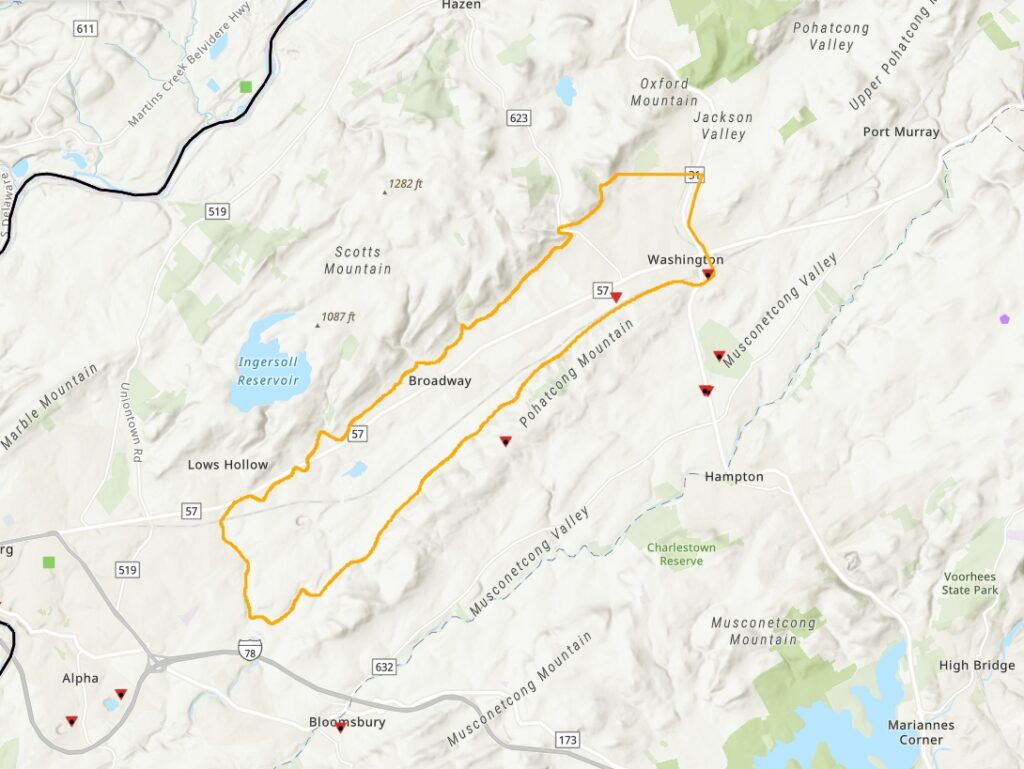
For more information:
- Superfund Site Profile Page
- https://www.justice.gov/archives/opa/pr/united-states-reaches-settlement-regarding-cleanup-superfund-site-warren-county-new-jersey
Franklin Township Committee Meetings
The township committee meets on the first Monday of the month at 7:00PM, unless advertised differently. The following is a schedule of the Regular Meetings of the Franklin Township Committee of the Township of Franklin, County of Warren to be held for the year 2025. All meetings unless otherwise indicated, shall be held at 7:00 p.m. at the Franklin Township Municipal Building, 2093 Rt. 57, Broadway, N.J. 08808. Please check the township website monthly for any changes to meeting dates/times: June 2, July 7, August 11, September 8, October 6, November 3, December 29 (Year End Mtg. @ 4pm), January 5, 2026.
Elected Local, State, and Federal Officials
*Currently we are creating a fillable form letter that can be completed with your name, address, and how many houshold members that are being affected from this contaminant in our drinking water, we would like to have each affected household or location of service, e-Mail, print and send it through the United States Postal Service, certified return reciept to all of our elected officials regarding this water contaminant crisis that has a compliance date of 2029 or further in the future.
Franklin Township Committee
David Guth, Mayor
908-689-3994 x25
[email protected]
Deputy Mayor: Rich Herzer, [email protected]
Committeeperson: Bonnie Butler, [email protected]
Committeeperson: Mike Toretta, [email protected]
Committeeperson: Sarah Payne, [email protected]
Federal:
President Donald J. Trump
The White House
1600 Pennsylvania Avenue NW
Washington, DC 20500
202-456-1111 (Comments)
202-456-1414 (Switchboard)
www.whitehouse.gov
Senator
Cory Booker
One Gateway Center
23rd Floor
Newark, NJ 07102
Phone: (973) 639-8700
306 Hart Senate
Office Building
Washington, DC 20510
202-224-3224
www.booker.senate.gov
Senator
Andy Kim
210 Hudson Street
Harborside 3, Suite# 1000
Jersey City, NJ 07311
973-645-3030
Dirksen Senate Office Building
Suite B-40D
Washington, DC 20510
202-224-4744
kim.senate.gov
The 7th Congressional District Includes all of Warren County.
Member of Congress
Seventh District
Tom Kean, Jr.
251 Cannon House Office Building
Washington, D.C. 20515
202-225-5361
kean.house.gov
Lebanon Borough District Office:
100 Corporate Drive, Suite 106
Lebanon, NJ 08833
908-547-3307
State:
- State Senate:
- District 23:
- Douglas J. Steinhardt (R)
- District Office: 127 Belvidere Avenue, Second Floor, Washington, New Jersey 07882.
- Phone: (908) 835-0552.
- District 24:
- Parker Space (R)
- District Office: 1 Wilson Drive, Suite 2B, Sparta, NJ 07820.
- Phone: (973) 300-0200.
- General Assembly:
- District 23:
- John DiMaio (R)
- District Office: 208 Mountain Avenue, Suite 3, Hackettstown, New Jersey 07840.
- Phone: (908) 684-9550.
- Erik Peterson (R)
- District Office: 28 Center Street, Clinton, New Jersey 08809.
- Phone: (908) 238-0251.
- District 24:
- Dawn Fantasia (R)
- District Office: 1 Wilson Drive, Suite 2B, Sparta, NJ 07820.
- Phone: (973) 300-0200.
- Mike Inganamort (R)
- District Office: 1 Wilson Drive, Suite 2B, Sparta, NJ 07820.
- Phone: (973) 300-0200.
Note: Warren County is split between the 23rd and 24th legislative districts. You can find more information about these districts and their representatives on the NJ Legislature website. You can also find information on the Warren County, NJ website.
County:
Board of County Commissioners of the County of Warren
Wayne Dumont, Jr. Admin. Bldg.
165 County Route 519 South
Belvidere, New Jersey 07823-1949
Board of County Commissioners (908) 475-6500 908-475-6528 (Fax)
Jason J. Sarnoski Commissioner Director Board of County Commissioners (908) 475-6519
Lori Ciesla, Commissioner Deputy Director Board of County Commissioners (908) 475-6517
James R. Kern III Commissioner Board of County Commissioners (908) 475-6518
Regular Meetings of the Board of County Commissioners of the County of Warren. All regular meetings shall be held in the Commissioner Meeting Room, Wayne Dumont, Jr. Administration Building, 165 County Route 519 South, Belvidere (White Township), New Jersey.
2025 County Commissioners Meeting Schedule:
Board of County Commissioners Regular Meeting 05/14/2025 6:00 PM
Board of County Commissioners Regular Meeting 05/28/2025 6:00 PM
Board of County Commissioners Regular Meeting 06/11/2025 6:00 PM
Board of County Commissioners Regular Meeting 06/25/2025 6:00 PM
Board of County Commissioners Regular Meeting 07/09/2025 6:00 PM
Board of County Commissioners Regular Meeting 07/23/2025 6:00 PM
Board of County Commissioners Regular Meeting 08/13/2025 6:00 PM
Board of County Commissioners Regular Meeting 08/27/2025 6:00 PM
Board of County Commissioners Regular Meeting 09/10/2025 6:00 PM
Board of County Commissioners Regular Meeting 09/24/2025 6:00 PM
Board of County Commissioners Regular Meeting 10/08/2025 6:00 PM
Board of County Commissioners Regular Meeting 10/22/2025 6:00 PM
Board of County Commissioners Regular Meeting 11/12/2025 6:00 PM
Board of County Commissioners Regular Meeting 11/25/2025 6:00 PM
Board of County Commissioners Regular Meeting 12/10/2025 6:00 PM

How You Can Help
We are building a community contact list of concerned residents who want to stay informed or join in future action.
Please email us your:
- Name
- Address
- Phone number
- Number of people in your household
Email: [email protected]
Serving: Warren County, NJ (New Jersey American Water customers)
Contact
Email us your name, address, phone number, preferred email(s), and household size to: [email protected]
Location
Warren County, “New Jersey American Water” Service Customers
